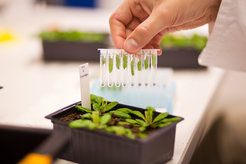Evolution & Adaptation
Detlef Weigel
Phenotype-driven approaches for the identification of natural variants with potential roles in adaptation continue to be an important part of our research.

Much of our work focuses on the plant Arabidopsis thaliana, which can be found in very different habitats, and the species accordingly varies in many morphological, physiological and life history traits. Several traits are likely to be important for local adaptation, such as the onset of flowering. This is less obvious for others, but their investigation can nevertheless lead to interesting biology.
In addition to genotype x environment (GxE) interactions, we are interested in genotype x gene (GxG) interactions, that is, how the expression of mutant phenotypes is modulated by genetic background. The experimental strategy employs CRISPR/Cas9 genome editing to knock out the same genes in different natural accessions. These efforts are an important step toward exploiting naturally occurring genetic variation for a systems-level understanding of biological processes.
A particularly fascinating case of evolution that can be observed in real time is that of herbicide resistance in agricultural weeds. Although many of the responsible genes are well known, there are still many questions regarding the frequency with which herbicide resistance arises, how it spreads, and how herbicide resistance mutations interact with other variants that ensure the success of weeds in agricultural environments.
- Natural variation in fitness trade offs
- Systematic analysis of genotype-by-gene (GxG) interactions
- Evolution of herbicide resistance
Collaboration Partners
- Julia Kreiner, University of British Columbia, Canada
- Charles Fenster, University of Maryland, USA
- Patrick Tranel, University of Illinois, USA
